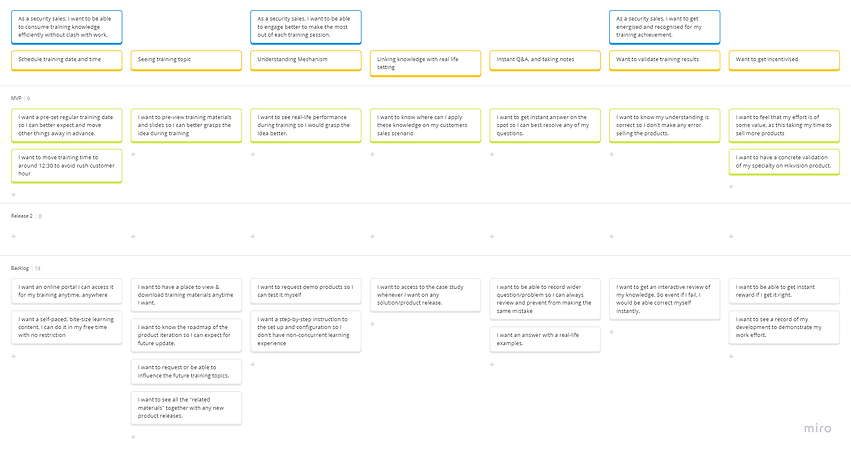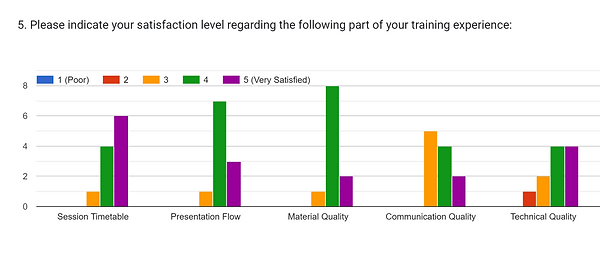
Hikvision Channel Training Portal
Iterative project to optimise channel customer training programme with the implication of increasing customer engagement and reducing organisational cost.
Overview
As a leading manufacturer in a multi-layered, technology-driven market, effective knowledge conveyance is crucial for product success. This is particularly true for Hikvision, as a brand from the Far East to operate in the UK markets, where language, geography, and regulation pose challenges. With COVID-19 hindering physical training sessions, I took the initiative to optimise the online training experience to enhance efficacy.
Through research, prototyping, and user feedback, I found that customers' ultimate concern is to strike a balance between their job responsibilities and mandatory technology updates (training). Based on these findings, the team and I refined our training format which increased over 25% attendance rate. Finally, this effort led to the headquarter's official iteration and launch of our online training portal across registered customers.
Setting Scope
Strategic Business Value:
-
Value Recognition: Training drives value recognition and knowledge conveyance in the security industry, addressing the knowledge gap where channel value lies.
-
Business Efficiency: Proper training ensures business efficiency and prevents resource waste.
-
Brand Engagement: Training sessions are the most direct form of brand engagement, building technology authority, trust, and rapport with customers, setting the brand apart from competitors.
Original Training Format:
Previous training sessions lacked standardisation as individual account managers were responsible for arranging the frequency, format, and topics aspect for their distributor(s). Inconsistent quality was observed due to variations in (Chinese expat) tech-support staff's language fluency and communication style, leading to significantly different training sessions for each distributor.
Challenges:
-
Lack of in-person training post-COVID decreased quality and delayed responses to questions.
-
The absence of non-verbal communication in online training increased reliance on precise language.
-
Online presentations often struggled to capture attention compared to in-person sessions.
-
Concurrent online training clashed with other job responsibilities, reducing the participation rate (<60%).
-
Distributors lacked intrinsic and extrinsic incentives to engage in the training.
Product Objectives:
-
Enhance user engagement (attendance) and increase users' product knowledge.
-
Establishing a standardised, adaptable framework tailored to future training sessions.
User Research
Survey:
A short survey was administered to 3 main distributor customers in my team (for communication and efficiency purposes) via a private link before a monthly training session. This is to make sure all participants are our target audience. Survey questions span from training preferences and concerns to unstructured open questions for open suggestions. See link here:
Results:
- Audience Demographics:
Total Responses: 48
Company Distribution:
Company A: 15
Company B: 13
Company C: 20
Department Representation:
Sales: 42 (87%)
Technical and Product Teams: 6
Demographics:
Gender: Predominantly male
Age Range: 28-55
Industry Experience: Many have CCTV installation or adjacent experience
Insights:
1. Target Audience:
Sales Team Focus: Salespersons are the primary target for training to effectively disseminate knowledge to end users.
2. Training Format and Efficiency:
Bite-Sized Learning: Respondents emphasize the need for frequent, efficient training sessions, suggesting a preference for bite-sized learning.
3. Training Delivery:
Language and Engagement: Improvements are needed in the delivery of training to enhance language fluency and engagement, despite materials being translated to English.
Trainer Expertise: Trust and learning authority is built through the trainer's knowledge and familiarity with the content.
4. Training Methods:
Visual Demonstrations: There is a strong preference for visual demonstrations, especially highlighted during the COVID-19 lockdown, where online training was appreciated.
5. Motivation and Rewards:
Intrinsic and Extrinsic Validation: Trainees show high interest in both monetary rewards and certificates, seeking validation through these incentives.
Persona:
A training user persona was built to focus our training optimisation on.
"I want continuing hardware product training prior to UK release"
---Internal Sales, Company A
"Hope to get Hikvision rep to train us, giving us USP and how they would sell the product."
---External Sales, Company B
"New product details at hand before the training"
---Branch manager, Company B





Prototyping & MVP User Testing
Prototyping: MVP Idea Prioritisation & User Story Map
An MVP prototype training system was created with the initial ideation and prioritisation based on my customers' feedback and team discussion, aiming to make the biggest impact on customers' training experience. However, due to technological constraints and a smaller testing scope (3 out of 11 distributor customers), the below prototype seeks to focus on training format and behavioural changes to test customer response.
-
Training Schedule:
-
Schedule regular training sessions to be once every 6 weeks, and create long-term expectations.
-
Moving training times to around 12:30 for 45 minutes to avoid rush customer hours and minimize conflicts.
-
-
Training Content and Knowledge:
-
Pre-send the training slides and product datasheet in advance, allowing pre-view beforehand.
- Prepare more real-life performance demo videos and confirmation instructions for the training to enhance practical/technical understanding.
- Include sales scenarios to training content make the training more relevant and practical.
- Create frequently asked questions (FAQ) slides for the training to help troubleshoot.
-
-
Knowledge Validation and Recognition:
-
Set up a short (10-item) online product quiz contest to validate participants' knowledge after training.
-
Acknowledge and validate achievements in training to motivate and recognize their participation:
-
Certificates for constant participation.
-
Rewards (Amazon voucher) for top scorer, best improvement, and participation on all training sessions.
-
-
A user story map is created to visualise the change made, and further iteration suggestions are left for (possible) future changes.
User Testing & Feedback
A prototype training system was implemented in subsequent customer training sessions. To validate its effectiveness in achieving the objectives of standardising the system and enhancing participant engagement and knowledge conveyance, a short survey was administered after the 3rd training since the change. The survey measured satisfaction and training quality. Alongside average quiz scores and attendance rates, I managed to see the performance of this effort.
-
Participants: All 15 training participants attended, and 11 responded to this survey. However, this result could be subjected to selection bias, low overall population and other contextual factors.
-
instantly it can be seen that more staff from other functions than sales showed up, whilst sales were still the majority.
-
Positive Experience: Over 72% rated their training experience positively (above 3).
-
Format Change: There was an even higher average sentiment toward the new training format.
-
Language Fluency: Trainers' language fluency was noted as a hindrance to learning.
-
Content Technicality: Training was perceived as too technical.
-
Fractured Information: Training details shared were reported to be fractured and scattered. Increased the difficulty of grasping the bigger picture.
Metrics Review
-
Participation rate: 100% (86%; 93% in 2 previous training)
-
Average Score: 74% (72%; 65% in 2 previous training)
-
Participant satisfaction: 3.81 (average)
-
Material Quality: 4.09/5 (average)
-
Communication Quality: 3.72/5 (average)
-
Technical Quality: 4/5 (average)
Reflection
This prototype significantly resolves the participation rate issue in the online environment via training format change and presents participants with clearer expectations and preparation. Customers' positive training experience feedback also confirms the content quality and the ease of content consumption from the knowledge point of view. However, a few issues remained/emerged.
-
Language/Communication fluency is still said to be one of the factors influencing the learning experience. This is understandable as Chinese expat tech support will never reach language fluency as a person with English mother tongue.
-
The training however is empowered by well-equipped materials/information, receiving them from various sources (emails, links, during sessions) could mean the access and storage of these could pose another issue for all learners.
-
Content technicality could distract salespersons from learning sales-oriented knowledge.
-
There's a need for tracking learning records and quiz records as people are motivated to actively participate in training for rewards.




Handover & Final (Current) Iteration
HQ Handover
The successful prototype test amongst my customers finally raised the management team's interest, leading to a decision to expand further optimisation to the wider customer base. The team decided to leverage Hikvision's global website and HQ technical capabilities to create a flexible training portal for distributor customers. This portal aims to provide standardised Hikvision training quality without time and space constraints. The development of the web portal was assigned to HQ colleagues, who then took over subsequent actions until its launch.
The strategic benefits of this initiative fall on addressing issues previously unresolvable by the UK team.
-
Resource Leverage and HQ Buy-In:
-
Utilizes wider resources and gains HQ permission to service the UK customer base effectively.
-
-
Unified Integration:
-
The training portal, integrated with Hikvision's global website, enhances UK customers' value recognition and aligns with the overall brand image.
-
-
Single Platform Advantages:
-
A unified platform with traceable records of sessions, materials, and performance improves customer expectations and management.
-
Product Development & Launch
Upon handing over, all testing results and customer insights were feedback summarised and feedback to the HQ dev team. After internal testing and various customer input from other countries, the latest training portal iteration was announced and launched at the end of 2023.
https://elearning.hikvision.com/eu/
Overall most features proposed above remained with several additional features added:
-
Single Standardised Online Platform: Centralised training and quiz platform with individual user accounts to trace progress.
-
Self-Paced Training: Users can complete training at their own pace before the monthly deadline.
-
Reward System: Automatic Amazon vouchers are awarded for reaching certain achievements.
-
Quiz Pass Threshold: Quizzes have a pass threshold set at 70% correct answers.
Adoption Review
*Disclaimer: With no direct influence on the development, this review will remain on the basis of our original product objectives: increase engagement and customer knowledge.
After the launch in Q4'23, the initial 7 out of the 11 distributor customers adopted the platform. With an overall adoption number of 165 out of 244 qualified customer staff enrolled (66%) and 47% pass rate out of all. This number was changed to 63% and 59% respectively two months later.
Excluding seasonal (Christmas month) or any other contextual factors that could have affected this result. The feedback from my customer base indicated that a few reasons could have resulted in this figure drop:
-
Materials could be detracted from the sales-oriented materials for everyone to grasp.
-
More non-sales staff included in the training system could also mean the training platform needs to consider wider target audiences' needs and training focus, whilst training content remains on technical product-updated by the HQ on this platform.
-
The "online" & "monthly" (instead of every 6 months) format of training expectation could mean customers will need more frequent notifications to complete the training as no consistent training sessions are booked on their calendar anymore. They will have to remember to complete the training themselves.
Overall Reflection:
Reflecting on this training system, I feel a profound sense of achievement and personal growth. Leading this initiative during the COVID-19 pandemic, I learned the importance of adaptability and agile problem-solving. Engaging directly with customers provided invaluable insights, especially the addressing of these to reach our objective resulting in an astonishing 25% increase in attendance and positive feedback. The successful prototype test captured management's interest, leading to the decision to expand the initiative. Collaborating with the HQ team to develop a standardised training portal demonstrated the power of strategic alignment and resource leverage. The portal's launch and rapid adoption confirmed the project's success.
This journey across 2 years honed my skills in product management and user-centred design, significantly enhancing our training framework, improving customer engagement, and aligning our services with Hikvision's global standards. This project stands out as a milestone of my experience, reflecting both professional achievement and personal growth.

